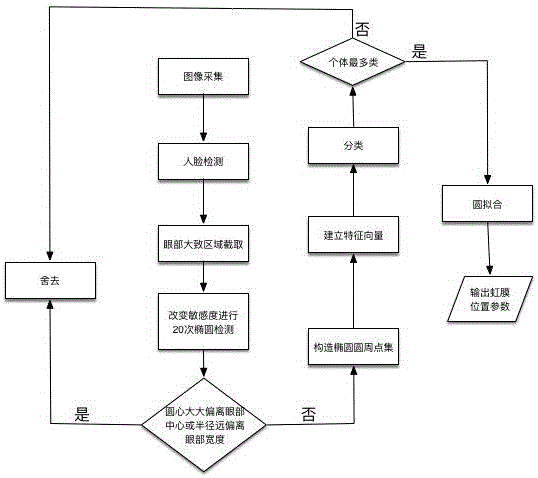Ellipse-detection-based iris detection method
A technology of ellipse detection and detection method, which is applied in the direction of instruments, character and pattern recognition, acquisition/recognition of eyes, etc. It can solve the problems of weak robustness, difficulty, misjudgment, etc., so as to improve accuracy, adaptability, and accuracy , the effect of increasing robustness
- Summary
- Abstract
- Description
- Claims
- Application Information
AI Technical Summary
Problems solved by technology
Method used
Image
Examples
Embodiment 1
[0040] like figure 1 Shown, a kind of iris detection method based on ellipse detection comprises the following steps:
[0041] Step 1: Obtain an image containing the eye region such as image 3 shown;
[0042] Step 2: Do ellipse detection on the eye area, such as Figure 4 shown;
[0043] The specific process of step 2 is:
[0044] Step 2-1: Use the ELSD algorithm to perform ellipse detection on the eye area: extract the gray value of the image, change the sensitivity of the ELSD, and perform N times in total to obtain the information of N groups of circles;
[0045] Step 2-2: According to the obtained circle information, construct the circle with the point set of the circle points in the circle information;
[0046] Step 2-3: For each point in the point set, construct the feature vector of the point, select the feature parameters of the point for weighting to obtain the feature vector, the feature parameters include the center coordinates, radius, arc, arc length, and ci...
Embodiment 2
[0051] On the basis of the above-mentioned embodiment, preferably, in step 2-1, after obtaining the information of N groups of circles, a screening operation needs to be performed. A circle that is offset from the center of the eye. Play the purpose of removing the interference parameters.
Embodiment 3
[0053] On the basis of the foregoing embodiments, preferably, the specific process of step 2-1 is:
[0054] Change the sensitivity of ELSD: the sensitivity is increased from M1 to M2 by 0.01 each time, and executed N times in total.
[0055] Every time the sensitivity of ELSD is changed, the ELSD algorithm is executed to perform ellipse detection on the area. There are three types of detection results, namely straight line, circle and ellipse. Turn it into a radius, turn the ellipse into a circle, and discard the straight line. After a total of N times, the information of N groups of circles is obtained. This step adopts multiple detections to obtain the information of N groups of circles, avoiding the influence of illumination and image quality.
[0056] Preferably, M1 is 0.7, M2 is 0.9, and N is 20.
PUM
 Login to View More
Login to View More Abstract
Description
Claims
Application Information
 Login to View More
Login to View More - R&D
- Intellectual Property
- Life Sciences
- Materials
- Tech Scout
- Unparalleled Data Quality
- Higher Quality Content
- 60% Fewer Hallucinations
Browse by: Latest US Patents, China's latest patents, Technical Efficacy Thesaurus, Application Domain, Technology Topic, Popular Technical Reports.
© 2025 PatSnap. All rights reserved.Legal|Privacy policy|Modern Slavery Act Transparency Statement|Sitemap|About US| Contact US: help@patsnap.com



